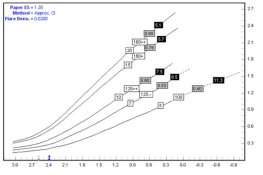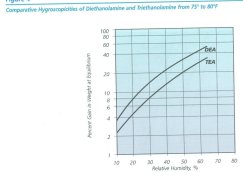This is kind of a work in process
Here is the tweaked Pyro-Uno formula.
Pyro-Uno
TEA (Triethanolamine) 80 ml
Ascorbic acid 1.4 g
Pyrogallol 3.4 g
Metol 0.4 g
TEA to make 100 ml
Mix chemicals in order listed. I mix with a hot plate stirrer at about 150F. Be patient as it takes a little time for the chemicals to dissolve
Working Solution: 1:50 to 1:200. 1:100 was used for the tests with FP4+.
Remember, this is a one-solution formula that you merely mix with water for the working solution. That is why the uno, which means one in Spanish.
I adjusted the formula to give a developer which when used at a dilution of 1:100 would give a curve very close to that of Pyrocat-HD used at 1:1:100. My testing is based on development in BTZS type tubes with constant, but gentle, agitation.
In BTZS testing five sheets of film are given identical exposures and then developed for a range of times. After the film is dry the negative step wedges are read with a densitometer and the values put into Winplotter. With Winplotter one can then run the program with different print exposure scales to calculate development time for a range of subject brightness conditions. For the testing here I set the ES to 1.35, which I find about right for printing with VC silver gelatin papers.
When you look at the charts you will see that each curve has four numbers. They are from left to right, 1) time of development, 2) effective film speed, 3) average gradient, and 4) SBR (subject brightness range).
The two tests were made with a different light source so the effective film speed is comparatively speaking not 100% correct. Also, the B+F values are not indicative as the Pyro Uno tests were carried out with FP4+ film that has been stored at room temperature for about three years and has developed a small amount of B+F.
Over the next several weeks I plan to carry out some real life tests comparing this developer to D76, and will post the results as they become available.
Sandy King
Here is the tweaked Pyro-Uno formula.
Pyro-Uno
TEA (Triethanolamine) 80 ml
Ascorbic acid 1.4 g
Pyrogallol 3.4 g
Metol 0.4 g
TEA to make 100 ml
Mix chemicals in order listed. I mix with a hot plate stirrer at about 150F. Be patient as it takes a little time for the chemicals to dissolve
Working Solution: 1:50 to 1:200. 1:100 was used for the tests with FP4+.
Remember, this is a one-solution formula that you merely mix with water for the working solution. That is why the uno, which means one in Spanish.
I adjusted the formula to give a developer which when used at a dilution of 1:100 would give a curve very close to that of Pyrocat-HD used at 1:1:100. My testing is based on development in BTZS type tubes with constant, but gentle, agitation.
In BTZS testing five sheets of film are given identical exposures and then developed for a range of times. After the film is dry the negative step wedges are read with a densitometer and the values put into Winplotter. With Winplotter one can then run the program with different print exposure scales to calculate development time for a range of subject brightness conditions. For the testing here I set the ES to 1.35, which I find about right for printing with VC silver gelatin papers.
When you look at the charts you will see that each curve has four numbers. They are from left to right, 1) time of development, 2) effective film speed, 3) average gradient, and 4) SBR (subject brightness range).
The two tests were made with a different light source so the effective film speed is comparatively speaking not 100% correct. Also, the B+F values are not indicative as the Pyro Uno tests were carried out with FP4+ film that has been stored at room temperature for about three years and has developed a small amount of B+F.
Over the next several weeks I plan to carry out some real life tests comparing this developer to D76, and will post the results as they become available.
Sandy King







